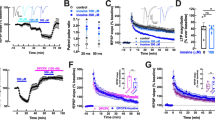Abstract
Ibotenic acid (Ibo) has been shown to have agonist activity at both theN-methyl-d-aspartate (NMDA) andtrans-ACPD or metabolotropic quisqualate (Qm) receptor sites in several systems. Both of these receptor sites have been implicated in excitotoxicity. Like NMDA neurotoxicity, Ibo neurotoxicity can be enhanced by glycine and blocked by MK-801. Ibo induced stimulation of phosphoinositide (PI) hydrolysis, on the other hand, is unaffected by either of these treatments. We therefore conclude that Ibo is capable of acting at both NMDA andtrans-ACPD receptors in the CNS, although only activation of NMDA receptors is involved in Ibo neurotoxicity. This conclusion leads us to postulate that stimulation of phosphoinositide hydrolysis is neither necessary nor sufficient for neurotoxicity.
Similar content being viewed by others
References
Choi D. W., Maulucci-Gedde M. A., and Kreigstein, A. R. (1987) Glutamate neurotoxicity in cortical cell culture.J. Neurosci. 7, 357–368.
Choi D. W. (1987) Ionic dependence of glutamate neurotoxicity.J. Neurosci. 7, 369–379.
Collingridge G. L. and Bliss T. V. P. (1987) NMDA receptors: Their role in long-term potentiation.Trends Neurosci. 10, 288–293.
Costa E., Guidotti A., Manev H., Szekely A. M., and Wroblewski J. T. (1988) Signal transduction at excitatory amino acid receptors: Modulation by gangliosides.Neurol. Neurobiol. 46, 29–38.
Cotman C. W., Monaghan D. T., and Ganong A. H. (1988) Excitatory amino acid neurotransmission: NMDA receptors and Hebb-Type synaptic plasticity.Annu. Rev. Neurosci 11, 61–80.
Coyle J. T., Bird S. J., Evans R. H., Gulley R. I., Nadler J. V., Nicklas W. J. and Olney J. W. (1981) Excitatory amino acid neurotoxins: Selectivity, specificity and mechanisms of action.Neurosci. Res. Prog. Bull. 19, 331–427.
Crunelli V., Forda S., and Kelly J. S. (1983) Blockade of amino acid-induced depolarizations and inhibition of excitatory post-synaptic potentials in rat dentate gyrus.J. Physiol. 341, 627–640.
Cull-Candy S. G. (1976) Two types of extra-junctional glutamate receptors in locust muscle fibers.J. Physiol. 255, 449–464.
Dichter M. A. (1978) Rat cortical neurons in cell culture: Culture methods, cell morphology, electrophysiology, and synapse formation.Brain Res. 382, 279–293.
Downes C. P., Hawkins P. T., and Irvine R. F. (1986) Inositol 1,3,4,5-tetrakisphosphate and phosphatidylinositol 3,4-bisphosphate are the probable precursors of inositol 1,3,4-trisphosphate in agonist-stimulated parotid.Biochem. J. 238, 501–506.
Foster A. C. and Fagg G. E. (1984) Acidic amino acid binding sites in mammalian neuronal membranes: Their characterization and relationship to synaptic receptors.Brain Res. Rev. 7, 103–164.
Garthwaite G. and Garthwaite J. (1989) Quisqualate neurotoxicity: A delayed, CNQX-sensitive precess triggered by a CNQX-insensitive mechanism in young rat hippocampal slices.Neurosci. Lett. 99, 113–118.
Honore T., Davies S. N., Drejer J., Fletcher E. J., Jacobsen P., Lodge D., and Nielsen, E. N. (1988) Quinoxalinediones: Potent competitive non-NMDA glutamate receptor antagonists.Science 241, 701–703.
Johnson J. W. and Asher P. (1987) Glycine potentiates the NMDA response in cultured mouse brain neurons.Nature 325, 529–531.
Johnston G. A. R., Curtis D. R., deGroat W. C. and Duggan A. W. (1968) Central actions of ibotenic acid and mucimol.Biochem. Pharmacol. 17, 2488, 2489.
Kemp J. A., Priestly T., and Woodruff G. N. (1986) MK-801, a novel, orally active anticonvulsant is a potent non-competitiveN-methyl-d-aspartate receptor antagonist.Br. J. Pharmacol. Proc. (Suppl.) 89, 535P.
Manzoni O., Fagni I., Pin J.-P., Rassendren F., Poulat F., Sladeczek F., and Bockaert J. (1990) (Trans)-1-aminocyclopentyl-1,3-dicarboxylate stimulates quisqualate phosphoionositide-coupled receptors but not ionotropic glutamate receptors in striatal neurons andXenopus oocytes.Mol. Pharmacol. 38, 1–6.
Mayer M. L. and Westbrook G. L. (1987) The physiological action of excitatory amino acids in the vertebrate central nervous system.Prog. Neurobiol. 28, 197–276.
Mayer M. L. and Westbrook G. L. (1987a) Permeation and block ofN-methyl-d-aspartate receptor channels by divalent cations in mouse cultured central neurons.J. Physiol. 394, 501–527.
Nicoletti F., Wroblewski J. T., Novelli A., Alho H., Guidotti A., and Costa E. (1986) The activation of inositol phospholipid metabolism as a signal transducing system for excitatory amino acids in primary cultures of cerebellar granule cells.J. Neurosci. 6(7), 1905–1911.
Olney J. W. (1987) Revelations in excitotoxicity: What next?Neurol. Neurobiol. 46, 589–596.
Patel J., Moore W. C., Thompson C., Keith R. A., and Salama A. I. (190) Characterization of the quisqualate receptor linked to phosphoinositide hydrolysis in neurocortical cultures.J. Neurochem. 54, 1461–1465.
Patel J., Zinkand W. C., Thompson C., Keith R., and Salama A. (1989) Role of glycine in theN-methyl-d-aspartate-mediated neuronal toxicity.J. Neurochem. 54, 849–854.
Patel J., Zinkand W. C., Klika A. B., Mangano T. J., Keith R. A., and Salama A. I. (1990a) 6,7-Dinitroquinoxaline-2,3-dione blocks the cytotoxicity ofN-methyl-d-aspartate and kainate but not quisqualate in cortical cultures.J. Neurochem. 55, 114–121.
Reynolds I. J. and Miller R. J. (1988) Multiple sites for the regulation of the NMDA receptor.Mol. Pharmacol. 33, 581–584.
Schwarcz R., Hokfelt T., Fuxe K., Jonsson G., Goldstein M., and Terenius L. (1979) Ibotenic acid-induced neuronal degereration: A morphological and neurochemical study.Exp. Brain Res. 37, 199–216.
Sladeczek F., Pin J. P., Recasens M., Bockaert J., and Weiss S. (1985) Glutamate stimulates inositol phosphate formation in striatal neurons.Nature 317, 717–719.
Watkins J. C. and Evans R. H. (1981) Excitatory amino acid transmitters.Annu. Rev. Pharmacol. Toxicol. 21, 165–204.
Wong E. H. F., Kemp J. A., Priestly T., Knight A. R., Woodruff G. N., and Iversen L. L. (1986) The anticonvulsant MK-801 is a potentN-methyl-d-aspartate antagonist.Proc. Natl. Acad. Sci. USA 83, 7104–7108.
Wroblewski F. and LaDue J. S. (1955) Lactic dehydrogenase activity in blood.Proc. Soc. Exp. Biol. Med. 90, 210–213.
Author information
Authors and Affiliations
Rights and permissions
About this article
Cite this article
Zinkand, W.C., Moore, W.C., Thompson, C. et al. Ibotenic acid mediates neurotoxicity and phosphoinositide hydrolysis by independent receptor mechanisms. Molecular and Chemical Neuropathology 16, 1–10 (1992). https://doi.org/10.1007/BF03159956
Received:
Accepted:
Issue Date:
DOI: https://doi.org/10.1007/BF03159956




